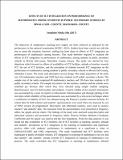Effects of ICT Integration on Performance of Mathematics among Students in Public Secondary Schools in Mwala Sub-County, Machakos County

View/
Date
2017Author
Silu, Josephine Nduku
Type
ThesisLanguage
enMetadata
Show full item recordAbstract
The objectives of mathematics teaching have largely not been achieved as indicated by the performance in the national examination (KNEC, 2015). Studies have been carried out with the aim to arrest the situation; however, nothing has been done on effects of ICT integration on performance of mathematics among learners. This study therefore required to examine the effects of ICT integration on performance of mathematics among students in public secondary schools in Mwala Sub-county, Machakos County, Kenya. The study was steered by four objectives which focused on effects of availability of ICT facilities, attitude of teachers towards ICT, the use of ICT facilities, and the perception of students towards ICT integration on the performance of mathematics among students in public secondary schools in Mwala Sub-County, Machakos County. The study used descriptive survey design. The target population of the study was 132 mathematics teachers and 3158 form four students in 65 public secondary schools. The sample size of the study comprised 40 mathematics teachers and 316 form four students in 20 public secondary schools. The sample size matrix for the teachers, students and the schools were stratified per division after which they were selected using simple random sampling. Questionnaires were for both teachers and students. Content validity of the research instruments was ascertained by a team of experts in Educational Administration and through piloting of the test items while reliability of the questionnaires was ascertained by a test-re-test technique where a coefficient of stability of 0.92 was obtained using the Pearson’s product moment formula. To collect data for both teachers and students’ questionnaires were used. Data was analyzed by use of SPSS version 20 programmed. Descriptive and inferential statistics were used to analyze teachers’ and students’ data. The outcomes from the questionnaires were presented in frequency tables, bar graphs and pie charts. The findings of the study were analyzed using descriptive and inferential statistics and presented in frequency tables. Pearson Product Moment Correlation Coefficient and chi square was used to test the four hypotheses. From the data analysis, it was found out that availability of ICT facilities, use of ICT facilities in teaching, teachers’ attitude and students’ perceptions on ICT integration in the teaching of mathematics had significant positive effect with students’ performance in mathematics at a significant p value of 0.003,0.015,0.005 and 0.002 respectively. The study established that ICT facilities were inadequate in public secondary schools, ICT integration in teaching of mathematics was low and that teachers’ and students’ attitude towards ICT integration in teaching of mathematics was positive. The study concluded that ICT integration in teaching of mathematics affected performance of students in mathematics in public secondary schools in Mwala Sub County. The recommendations of the study were that mathematics curriculum should be designed to fully prepare the students with the skills useful in the technology dominated society and that ICT integration in the teaching of mathematics be made compulsory for all the students. Further, research should be undertaken on student’s level of adaptability to the work environment after acquiring ICT skills in secondary schools
Publisher
Africa Nazarene University
Subject
ICT IntegrationAttitude of teachers towards ICT
The use of ICT facilities
Perception of students towards ICT integration
Collections
- Education [59]
